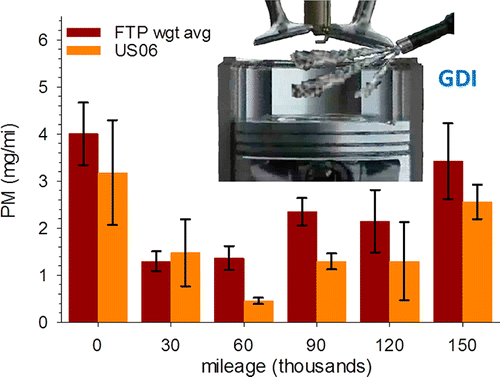An engine design appearing under the hoods of many new cars and light trucks today is close to meeting the latest pollution standards that will require vehicles to emit fewer harmful particles over their lifetimes, scientists are reporting. The new study on emissions from gasoline direct injection (GDI) technology appears in the ACS journal Environmental Science & Technology.
Matti Maricq and colleagues explain that to meet new regulations, vehicle manufacturers need to make cars both more fuel-efficient and less polluting, which can be a difficult engineering challenge. In 2012, California approved standards to reduce emissions from passenger cars to 3 milligrams, or a millionth of an ounce, per mile over the 2017-2021 automobile model years. Particulate matter in emissions is associated with health problems, such as asthma and other lung conditions. The U.S. Environmental Protection Agency has proposed the same target and expects it to remain consistent for 150,000 miles of a vehicle's lifetime. In the meantime, car manufacturers have been putting more cars with GDI technology, which boosts fuel efficiency by injecting gasoline straight into a vehicle's combustion chamber, on the market. But no one had looked at the emissions picture over the lifetime of these fuel-efficient vehicles to see if GDI cars can also meet the new particulate matter standards.
They tested the particle emissions from two GDI vehicles. They found in these examples that the emissions hovered near or below the limit set by the new California and EPA standards over a lifetime of 150,000 miles.
More information: "Influence of Mileage Accumulation on the Particle Mass and Number Emissions of Two Gasoline Direct Injection Vehicles" Environ. Sci. Technol., 2013, 47 (20), pp 11890–11896. DOI: 10.1021/es402686z
Abstract
Gasoline direct injection (GDI) is a new engine technology intended to improve fuel economy and greenhouse gas emissions as required by recently enacted legislative and environmental regulations. The development of this technology must also ensure that these vehicles meet new LEV III and Tier 3 emissions standards as they phase in between 2017 and 2021. The aim of the present paper is to examine, at least for a small set, how the PM emissions from GDI vehicles change over their lifetime. The paper reports particle mass and number emissions of two GDI vehicles as a function of mileage up to 150K miles. These vehicles exhibit PM emissions that are near or below the upcoming 3 mg/mi FTP and 10 mg/mi US06 mass standards with little, if any, deterioration over 150K miles. Particle number emissions roughly follow the previously observed 2 × 1012 particles/mg correlation between solid particle number and PM mass. They remained between the interim and final EU stage 6 solid particle count standard for gasoline vehicles throughout the mileage accumulation study. These examples demonstrate feasibility to meet near-term 3 mg/mi and interim EU solid particle number standards, but continued development is needed to ensure that this continues as further fuel economy improvements are made.
Journal information: Environmental Science & Technology
Provided by American Chemical Society





















